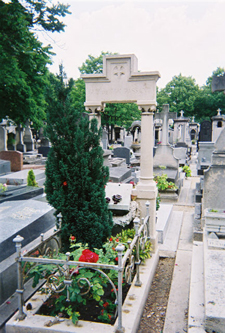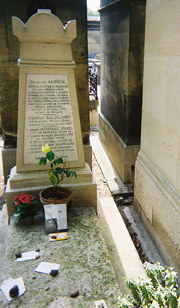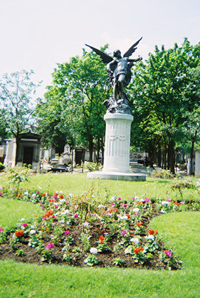|

Guy de Maupassant's grave at Montparnasse
Finding Jean
Essay and photos by Steve
Honeywell
When my father was a young man on the campus of the University of
Iowa, he saw the world's most beautiful woman. Leaning in to a friend,
he remarked, "That's the girl I'm going to marry."
She was Jean Seberg. Like a lot of young women on the Iowa campus,
Jean had pledged a sorority. Here she was placed in an alphabetical
row with the other pledges. My father, with a little investigative work,
figured out where Jean lived and got a job as a server. He paid special
attention to one section of the table.
Jean left school after a couple of weeks. She'd been selected out
of 18,000 hopefuls to star in Otto Preminger's "Saint Joan."
So while she went to Paris, Dad turned his attention to Jean's pledge
partner and alphabetical neighbor, Carol Skidmore, my mother.
As I prepared for a trip to Paris, Mom asked me to look up Jean
and say hello. Mom remembered her not as the tempestuous star but as
the simple Iowa girl. I told her I'd do my best.
These days, Jean Seberg's place is a 10-minute walk from the Edgar
Quinet Metro stop. It's 200 feet or so inside the front gate of Montparnasse
Cemetery.
European cemeteries have an advantage over American ones: they're older,
and because of this have more interesting residents. There are two cemeteries
of note in Paris. The first, Perè Lachaise, gets most of the
attention because it houses Frederick Chopin, Oscar Wilde, and Jim Morrison.
I prefer Montparnasse. It's smaller than Perè Lachaise, but at
the same time, feels more open. Part of this openness comes from the
road that cuts the cemetery in two.
In European cemeteries, the graves are almost on top of one another.
In Montparnasse, almost all of the graves have large, above-ground sarcophagi
packed so close together that moving between them is not unlike squeezing
through a crowd. The rows of resting places go four, five, six deep.
Finding someone in the third row means stepping over or on someone in
the first two.
What also amazes me is that that space for new monuments still exists.
There doesn't appear to be any available place that would fit the body
of a cat, let alone an adult human, yet the guard at the front gate
tells me that the cemetery is still far from full.
Napoleon planned Montparnasse. Back then, it was presumed that cemeteries
were breeding grounds for disease, so the original plan was to place
this site outside of the city limits of Paris. History doesn't record
who actually laid out the design of the cemetery — if it was Napoleon,
he may have been better at cemetery planning than empire management.
Montparnasse is beautifully arranged, with wide, paved avenues and tall
trees that border the graves. Between the rows of monuments are narrow
footpaths that brush directly against the tombs.
Inside the front gate, a guard stands observing people coming in and
out. I ask him if he has a map of the grounds I can use, not trusting
my thick Paris guidebook to properly locate the people I wanted to visit.
He nods and points to a small collection of papers. Fold-out maps. Armed
with this and the guidebook that suggests interred notables, I set out
to find some old friends.
Near the guard I find the first of many. Jean Paul Sartre and collaborator
Simone de Beauvoir are a few steps inside the front gate. Sartre would
be pleased by the unintentional irony of his final resting place. The
author of No Exit is buried 30 feet from the way out.
Jean Seberg committed suicide at the end of August in 1979. She
had been missing for more than a week, and her family and friends assumed
the worst. Her body was found wrapped in a blanket in the back seat
of her car not far from her apartment in Paris. She had been dead nearly
11 days. Sartre and de Beauvoir were among the many who attended her
funeral. Her parents stayed in Iowa.

Baudelaire's grave
The paved road heads toward the outside wall and turns abruptly to
the left. According to the map, Charles Baudelaire is buried somewhere
around the corner. Ahead of me, a French couple walks hand-in-hand.
He is carrying the same map from the front gate; she holds the same
guidebook I have, a finger stuck between the pages. Around the corner,
I am stumped at locating poor Baudelaire. I hunt in vain for him, pacing
back and forth between rows of tombs. The woman notices my frustration
and taps me on the shoulder, then points to a white column a few feet
away. It's him. Unsure of the language barrier, I smile and say thank
you. She returns the smile, and she and her husband wander off.
Baudelaire's writing was scandalous for its time, concentrating on
themes of sex, death, and evil. He worshipped his mother and was in
many ways terrorized by his step-father, Jaques Aupick. It is appropriate
in a Baudelairean sense, then, that poor Charles is buried here, beneath
the body of his step-father.
The road continues, running parallel to the outside wall. I pass a
number of interesting tombs, some plain, others ornate, still others
topped with replica statuary. In the distance is a large structure.
Unconsciously, I walk toward it, drawn to it without knowing what it
is.
The structure is all that is left of what once stood on the grounds
of Montparnasse. It is the remains of a windmill that once served the
Brothers of Charity monastery of that stood here. The land was given
over to the government to assist in moving cemeteries out of Paris proper.
Back then, Montparnasse was known as Cimetière du Sud,
the southern cemetery. The mill is locked and chained.
I have told my father that I planned to visit Montparnasse. His
reaction is difficult to gauge. Since bringing it up, he has relived
some of his youthful infatuation with Jean Seberg, and like my mother,
has asked me to get a picture of her grave. He endures his share of
teasing at the hands of his children on this trip. At every dinner,
my brother and sisters ask me if I've visited "Dad's girlfriend"
yet. The joke, of course, is that Dad never really knew her; he just
served her dinner. It was Mom who she was friends with. Had Jean become
another suburban housewife, his own infatuation would be long forgotten.

Angel of Eternal Sleep
Near the center of the Grand Cimetière is a huge marble
pillar. At the top stands the Génie du Sommeil Eternel,
the Angel of Eternal Sleep. She looks toward the front entrance, casually
observing those who wander among the tombs. According to the map, French
singer and poet Serge Gainsbourg is buried nearby, but once again, I
cannot find him. I tap a guard lightly on the shoulder and ask him to
help. He smiles and says, "Ah, you are looking for dear Serge!
He is right over here." We walk a few paces from the angel, and
he points to a monument covered in flowers and photographs. I have missed
it because it was right in front of me.
Gainsbourg was a controversial figure in his own right. His most famous
contribution to the musical world was the song "Je t'aime…moi
non plus." The song, which translates roughly as "I love
you… me neither," features the simulated orgasm of his soon-to-be
girlfriend, Jane Birkin. Brigitte Bardot did the part originally, but
pulled out on the insistence of her husband. The song reached number
one in the U.K. in 1969 and was cited specifically by the Vatican as
offensive.
Gainsbourg's death in 1991 was a national tragedy. François
Mitterand called him the generation's Baudelaire.

|